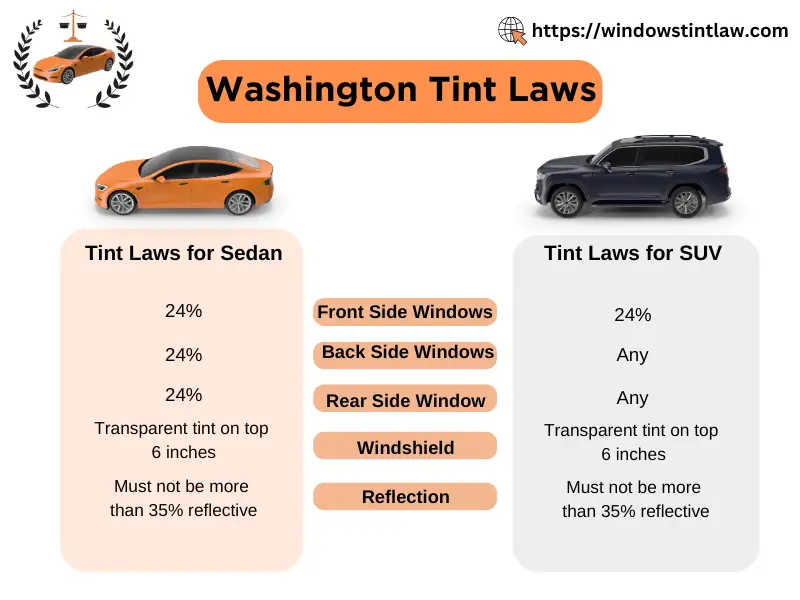Washington tint laws were legislated in 1993 for safety of vehicle operators and passengers.
Washington window tinting laws allow 24 percent of Visible Light Transmission through glass films. Secondly, Vehicles must have Solar reflectance of not more than 35%.
For the detailed insights about Washington tint laws for Cars and SUVs, check the below sections:
Overview of Washington Tint Laws
The below image illustrates the legal tint darkness and tint reflection limits for Cars and SUV or Trucks. Drivers must comply with these tint limits to avoid legal consequences and penalties.
The below percentages refers to Visible light transmission percentages, which means the percentage of Light that must pass through the vehicle windows with coating material applied.

Darkest Legal Tint in Washington
Follow the below tables to check the darkest legal tint limits for Cars and Trucks or multipurpose vehicles registered in Washington.
Windows Tint Darkness For Sedan or Cars
| State | Front Side Windows | Back Side Windows | Rear Window | Windshield | Tint Reflection | Restricted Tint Colors |
| Washington | 24% | 24% | 24% | 6 inches from Top | Not more than 35% reflective. | Red, Gold, Yellow or Black color tints are restricted. |
Windows Tint Darkness For SUV or Trucks
| State | Front Side Windows | Back Side Windows | Rear Window | Windshield | Tint Reflection | Restricted Tint Colors |
| Washington | 24% | Any | Any | 6 inches from Top | Not more than 35% reflective. | Red, Gold, Yellow or Black color tints are restricted. |
Window Tint Reflection
Tinting laws in Washington permits the solar reflectance of vehicle windows must not be more than 35%. This rule is applicable for Cars and Trucks for front and back side windows.
Drivers must follow the said tint reflection limits, hence applying the right tint type is recommended which should be non reflective.
Other Rules for Vehicles with Tinted Windows
Besides window tint darkness and tint reflection limitations, there are some other rules for vehicles operated in Washington:
- Dual Side Mirrors: Side mirrors on both sides are mandatory, if the back window is covered with tinting or coating material.
- Restricted Colors: Red, Gold, Yellow and black color tints are restricted in Washington.
- Certificates: Window Film manufacturers need to certify the film they sell in Washington.
- Stickers: The sticker or label is required to display on the driver’s side window. Sticker identifies the tint complies with state laws.
Medical Exemption
According to Washington Revised Code for Motor Vehicles Title 46 Section 46.37.430 , Any individual can obtain medical exemption or tint waiver based on physical or medical reasons. However, Verification is required from the licensed physician which must state that person requires protection from direct sunlight due to medical condition.
Moreover, For any further details about Medical Exemption information in Washington, consult with nearest DMV office.
Penalties for Violating Tint Laws
Law enforcement agencies in Washington check for window tinting laws and drivers with illegal tint may get pulled over if police suspects illegal tint is applied. Police can test tinted or coated windows with an electronic Tint meter to determine if the VLT percentage is within allowed limits.
Additionally, In case of non-compliance with State tint laws, you may get the tint ticket and Cops will ask to remove the illegal tint. The exact value of tint ticket varies according to severity of violation.
Furthermore, Motor vehicles with illegal tints may get difficulties in inspections and registration processes.
